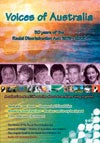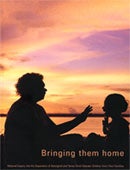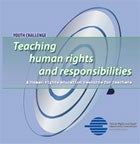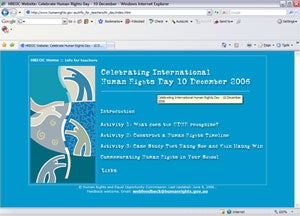Social Justice; HREOC and Indigenous Education
Archived
You are in an archived section of the website. This information may not be current.
This page was first created in December, 2012
Speech:
Social Justice; HREOC and Indigenous Education
Event:
National Education Forum General Meeting
Where: Australian College of Educators (the Boardroom)
James Darling House
42 Geils Court Deakin, Canberra
When: Saturday May 17
Time: 11.00am for 11.30am (see appendix 1)
An address by Tom Calma, Aboriginal and Torres Strait Islander Social Justice Commissioner and Race Discrimination Commissioner, Human Rights and Equal Opportunity Commission
Slide 1
Social Justice, HREOC and Indigenous Education
Tom Calma
Aboriginal and Torres Strait Islander
Social Justice Commissioner and
National Race Discrimination Commissioner
National Education Forum
Canberra, 17 May 2008
I would like to begin by acknowledging the traditional owners of the land where we meet, the Ngunnawal peoples.
I would also like to thank all of you, and Kathy Schoo in particular, for inviting me to speak today. It is a pleasure to speak to you all today about matters that are close to my heart; education, social justice and human rights.
Let me commence my presentation today by explaining briefly the role and functions of the Human Rights and Equal Opportunity Commission (HREOC). Following this I will discuss a range of issues concerning my work both as the Aboriginal and Torres Strait Islander Social Justice Commissioner and the National Race Discrimination Commissioner.
Role and Function of HREOC
So first let’s consider the role and function of HREOC.
HREOC is an independent statutory body, and we report to the federal parliament. HREOC is responsible for administering all of the federal acts dealing with discrimination, as well as the Human Rights and Equal Opportunity Commission Act 1986 (the HREOC Act). In total there are FIVE acts, which subsequently give HREOC a wide range of legal responsibilities.
Slide 2
The Human Rights and Equal Opportunity Commission (HREOC) is Australia’s federal human rights and anti-discrimination agency
Human Rights: Everyone, Everywhere, Everyday
Main legislation
- Age Discrimination Act 2004
- Disability Discrimination Act 1992
- Human Rights and Equal Opportunity Commission Act 1986
- Racial Discrimination Act 1975
- Sex Discrimination Act 1984
Speeches http://www.humanrights.gov.au/about/media/speeches/index.html
Reports http://www.humanrights.gov.au/social_justice/index.html
Submissions http://www.humanrights.gov.au/legal/submissions/index.html
Media http://www.humanrights.gov.au/about/media/index.html
Education http://www.humanrights.gov.au/education/index.html
All of the present Commissioners occupy dual roles within the Commission. I have a dual role as the Aboriginal and Torres Strait Islander Social Justice Commissioner and the National Race Discrimination Commissioner, which means that i deal with a large percentage of the issues faced by indigenous peoples and culturally and linguistically diverse communities. A sad irony is that Government has chosen to fund only three of the five Commissioner positions hence we perform one of our commissioner functions in an honorary capacity.
Slide 3
HREOC’s Functions
- Human rights education and promotion.
- Inquiring into discrimination and human rights complaints.
- Human rights monitoring.
- Policy development and legislative reform.
HREOC has a statutory function to promote understanding, awareness and public discussion of human rights in Australia.
HREOC has responsibilities for the promotion and protection of human rights under federal ‘human rights’ and anti-discrimination laws. This includes;
- monitoring government policy around civil and political rights,
- promoting an understanding of the laws that protect these rights, and
- actively assisting people in Australia to ensure they have access to the full protection of such rights.
Link to Audience
One of the greatest obstacles that hreoc faces is that there is a general lack of awareness in the public about what human rights actually are.
Human rights are historically interpreted in light of moral expectations set by various communities. More recently (since the development of international law and UN conventions), they have been articulated in various legal frameworks- often quite detailed and complex, particularly in the way that various jurisdictions overlap (eg international/ federal/ state).
Part of the reason that i am here today is to help you help those in your respective associations and organisations to understand human rights in the context of my work, and to be able to draw on the resources of HREOC, helping to ensure that our younger generations grow up with a greater understanding of their rights and the rights of those around them. We also need to consider, of course, the responsibility that each of us have in protecting and promoting these rights.
For educators there are clear overlaps between human rights topics and the study of social sciences, for example in the areas of geography and history, where students can appreciate the rights of peoples in different communities in relationship to their land and culture, and how those rights have developed and changed over time.
What is important for such teachers and curriculum developers to appreciate is that omissions in the curriculum relating to a particular community or group history equates to a denial of human rights. In this case HREOC works closely with curriculum developers to assist in considering human rights implications - an interesting exercise in the current climate.
There are also many human rights issues linked to subjects that aren’t so obvious:
- business studies teachers (in the form of workplace discrimination and understanding models of corporate behaviour)
- English, music and art teachers (dealing with forms of moral expression) and
- for both home economics teachers and personal development/ health/ physical education teachers (in ensuring students are familiar with family responsibilities, issues of sexual harassment and bullying).
Of course one of the most important functions of educators and school leaders is to ensure a safe and protected environment for learning, which means following an approach that is consistent with a respect for the responsibilities under the umbrella of a human rights approach.
At the Human Rights and Equal Opportunity Commission we see first hand (through our complaints process) where human rights breaches are occurring - which is why our educative role is of such importance. Human rights are for everyone, every where, every day, and we aim to increase societies understanding of this through all sectors of community.
Role as Race Discrimination Commissioner
As Race Discrimination Commissioner, my role specifically is to administer the Racial Discrimination Act and to take on a human rights education function.
A major focus for me as Race Discrimination Commissioner is the way in which Australia’s social policies, particularly those affecting people from culturally diverse backgrounds, are evolving in response to current trends and concerns. From a human rights perspective, our policies need to ensure that the right to enjoy and practice one’s culture and language without discrimination is protected. This right is a fundamental tenet of multiculturalism, a policy which emerged in the 1970s in many countries, including Australia, as a response to the increasing cultural diversity of society.
As you know Australia is one of the most diverse nations on earth. Australians speak some 364 languages, of which 170 are Indigenous languages and between 1996 and 1998, 52% of marriages in Australia were ‘mixed’ in the sense that they involved people from different countries of origin, and 45% of Australians have had one or both parents born overseas.
HREOC is currently coordinating several projects under the Federal government National Action Plan to build on social cohesion, harmony and security.
Some of these involve resource development of ESL materials; others focus on improving relationships between police and muslim communities, and assisting community cultural development initiatives.
Slide 6
Role of Aboriginal & Torres Strait Islander Social Justice Commissioner
- Specific reporting functions under HREOC Act and Native Title Act,1993 (Cth)
- Monitoring of the enjoyment or otherwise by Indigenous peoples of our native title rights and of our enjoyment of human rights under the law
- Annual Social Justice Report and Native Title Report
Human Rights: Everyone, Everywhere, Everyday
Role as Social Justice Commissioner
As the Social Justice Commissioner, my functions are to monitor the enjoyment and exercise of human rights for Indigenous Australians, which I do in a number of ways.
Under legislation I am required to produce annual Social Justice and Native Title Reports. These reports are tabled in the Federal Parliament each year.
The most recent Social Justice Report was tabled in Parliament on 20 March 2008 and focuses on issues relating to family violence and child abuse in Indigenous communities.
The report provides case studies of promising practices in dealing with violence, with lessons for government and for Indigenous communities.
It also contains a detailed analysis on the human rights implications of the Northern Territory intervention legislation. This includes a 10 point plan for modifying the intervention so that it is more effective and consistent with human rights standards. I’m happy to answer any questions on this topic at the end if you have them.
The most recent Native Title Report focuses on the workability of the native title system, which as some of you may be aware, has not adequately protected the rights and interests of native title holders.
Slide 7
Functions of the Social Justice Commissioner
- Report annually on exercise of rights
- Promote awareness and discussion
- Undertake research & educational programs
- Examine and report on legislation
- Report annually on the operation of the Native Title Act

Previous Native Title Reports have focused on how native title can contribute to promoting economic development on Indigenous land. There are a number of positive case studies where mining companies have supported health and education initiatives for Indigenous communities through indigenous land use agreements.
In addition to the reports, I have functions as Social Justice Commissioner to promote awareness and conduct educational activities to promote Indigenous people’s human rights. I do this in a number of ways. For example:
Slide 8
 The campaign for health equality
The campaign for health equality
OVERALL TARGET:
HEALTH STATUS EQUALITY WITHIN 25 YEARS
Targets and benchmarks as appropriate.
FOUNDATION TARGET:
EQUALITY OF OPPORTUNITY TO BE HEALTHY WITHIN 10 YEARS
Sub-target 1: Equality of access to primary health care within 10 years.
Sub-target 2: Equal standard of health infrastructure within 10 years
Close The Gap
A recent example of a very significant process that I have led is the Close the Gap Coalition (you may be aware of the OXFAM or ANTaR campaigns to promote the close the gap concept). This emerged from my Social Justice Report 2005 to the federal Parliament, where we made findings in relation to Indigenous health programs and services.
As you may be aware from the campaign, Indigenous people have significantly less access to primary health care, and health infrastructure in Indigenous communities is of a poorer standard than that in other communities. As a result, significant inequality exists across a range of health indicators – from life expectation to chronic and communicable diseases. At present the life expectancy of Indigenous people is estimated to be around 17 years lower than that for the total Australian population.
In the report I made a series of recommendations for achieving Aboriginal and Torres Strait Islander health equality within a generation. And over the past two years I have worked with a broad coalition of more than 40 peak bodies across the health, Indigenous health, NGO, reconciliation and human rights sectors to promote the findings of the report.
From 18-20 March this year we jointly convened a national indigenous health equality summit in canberra to propose, based on evidence, the intermediate targets necessary to meet the targets set out in the social justice report 2005 to close the life expectancy gap within a generation, and to ensure equal access to primary health care and health infrastructure within ten years.
Slide 9
Statement of Intent
The Statement of Intent commits the Government of Australia, Indigenous Australians, supported by non-Indigenous Australians and non-Indigenous health organisations to work together to achieve equality in health status and life expectancy between Indigenous and non-Indigenous Australians by the year 2030.
At the end of the summit, the Prime Minister, the Ministers for Health and Indigenous Affairs, the Opposition leader, Ian Thorpe, Catherine Freeman, and every major Indigenous and non-Indigenous health peak body, signed a Statement of Intent to work together to achieve Indigenous health equality by the year 2030. The statement means that benchmarks and targets for achieving health equality for Indigenous Australians are not only possible, but are now firm commitments.
Slide 10
There has been a commitment by those that have signed to:
- Develop a comprehensive long-term plan of action that is targeted to need, evidence-based and capable of addressing the existing inequality in health services in order to achieve equality of health status and life expectancy between Indigenous and non-Indigenous Australians by 2030.
COAG forum report
I was pleased to see recently that education ministers last month also endorsed COAG targets relating directly to Indigenous students in education and agreed to implement action plans in this area1.
Across Australia retention levels have been lower for Indigenous students, in many cases performance levels are lower, and school attendance is an ongoing issue in many communities. COAG targets to improve early childcare learning and to halve the gap in reading, writing and numeracy levels for Indigenous students, is certainly welcome. Improving education outcomes is essential to overcoming disadvantage, particularly for indigenous communities.
This year I will be following issues in Indigenous education more closely for the Social Justice Report (I would be keen to receive any feedback you may have on some of the programs currently in place and other issues in your communities).
As part of my educative role, I carry out a number of on-going education tasks such as speaking in public forums like this one. I also publish all of my speeches, reports and submissions on the HREOC website - thereby providing up to date information about my activities
Education Materials
I also develop specific education materials, some of which may be of specific interest to you or your colleagues.
One of the most recent resources that we developed is a training package for Indigenous family violence workers. The workers were educated in community development practices and the interaction of Australian law, customary aboriginal law, human rights, and family violence.
The role of these workers is now to support and educate Indigenous communities in order to prevent family violence, and to unlock the potential that communities have to solve their own problems and come up with their own solutions to prevent family violence.
We have also recently re-accredited national curriculum for the certificate and diploma level on Indigenous legal advocacy. This course provides accredited training options to Indigenous peoples.
Slide 13
Activities to dispel myths about refugees, migration and Indigenous Australia
http://www.humanrights.gov.au/racial_discrimination/face_facts/migrants.html
Later in the year i will be releasing our updated version of face the facts, one of our most popular resources, which includes statistical information on migrants, refugees and Indigenous Australians. Our education section on the website has downloadable teaching materials to complement this for use in the classroom.
Slide 14
Voices of Australia: activities to help combat racism and promote cultural understanding
https://humanrights.gov.au/our-work/education/publications/voices-australia-rightsed
The Voices of Australia collection includes a poster and a compilation of stories from everyday Australians about cultural harmony and overcoming racial stereotypes. This was originally produced as part of the celebration of 30 years of the Racial Discrimination Act in 2005.
(there is a copy of the printed education module available for you to take home today – the education module has activities for use in both primary and secondary classrooms.)
Slide 15
Bringing them home:The history of the separation of Aboriginal and Torres Strait Islander children from their families
https://humanrights.gov.au/our-work/bringing-them-home-report-1997
A resource collection that many of you would be familiar with, the Bringing them home series. These materials stem from HREOC’s national inquiry into the Separation of Aboriginal and Torres Strait islander children from their families, which culminated in the Bringing them home report in 1997.
Since 1997 there has been enormous public support, and the influx of requests from teachers for information led to the development of various education resources.
Last year for the tenth anniversary of this report, we updated the resources and re-released the education materials along with a classroom poster, a DVD and a collection of personal stories and artworks (us taken away kids). These resources are also available for you to take with you today, and further copies can be ordered directly through our publications department.
Slide 16
Human Rights: Everyone, Everywhere, Everyday
Contribution to public debate

As you can imagine, it was a momentous and joyful occasion in February this year, when Prime Minister Rudd Apologised to the stolen generations on behalf of the Australian Parliament. I was asked by the National Sorry Day Committee and the Stolen Generations Alliance to respond to the Parliament’s Apology.
In my mind the apology highlights the significance of HREOC’s work. Many of our inquiries and reports themselves have the result of educating people about human rights issues in Australia - about the necessity of monitoring compliance.
Some other similar examples of hreoc’s work, some of which have classroom activities linked to the report, include:
- the children in detention inquiry IN 2003 / 04 - which was conducted in order to examine whether or not there were breaches of human rights according to the convention on the rights of the child.
The Inquiry found that children in Australian immigration detention centres had suffered numerous and repeated breaches of their human rights.
In particular, the Inquiry found that Australia’s immigration detention policy failed to protect the mental health of children, failed to provide adequate health care and education and failed to protect unaccompanied children and those with disabilities. Children have since been removed from detention centres.
Slide 18
 Media release
Media release
30 April 2008
Government’s move on same sex discrimination welcomed by HREOC
Human Rights Commissioner Graeme Innes welcomes today’s announcement that discrimination against same-sex couples and their children will be removed from federal legislation.
- The same sex inquiry - which examined financial and work related entitlements of those in same sex relationships and found that there were 58 laws that were inconsistent. The government has recently introduced a bill aimed at amending these laws and an addition 40 plus laws.
Slide 19
Paid Maternity Leave
“Let’s use Mother’s Day to not only celebrate the enormous achievements mothers make every day but to go further and celebrate the mothers of tomorrow by making a case for paid maternity leave to the federal government’s current Inquiry,” Commissioner Broderick said.
- The current ongoing work in support of a national paid maternity leave scheme.
Slide 20
Teaching Human Rights & Responsibilities
- Introduction - What is Youth Challenge?
- Unit 1: Human Rights in the Classroom
- Unit 2: Disabilty Rights "But what about Doug's rights?'
- Unit 3: Young People in the Workplace
- Unit 4: Tackling Sexual Harassment
- The Youth Challenge series offers an introduction to human rights and complements the range of topics addressed by our human rights policy team, such as child rights, voting rights, and rights for those with a criminal record to name a few. The series also covers issues around disability rights, sexual harassment in the classroom and the rights of young people in the workplace.
For students, there are a number of simplified guides to human rights available via the education part of HREOC’S website.
- Recently we produced a range of fact sheets for students on the origin, philosophies and history of human rights titled ‘human rights explained’. This resource has proven extremely popular with the general public already, and by request, copies of it have been distributed to each Member of Parliament in the country - hopefully this indicates a positive move forward in greater human rights protection in Australia.
- There is also a more general ‘info for students’ page on HREOC’s website which has helpful links to how to start researching for assignments.
As the commission is essentially a small organisation we rely on partnerships to implement effective education programs.
For example, we work with groups such as Dare to Lead, Wakakirri (national story festival) and the human rights arts and film festival team. All of these groups use our resources for professional development programs, and rely on our expertise to help clarify the human rights message.
We also work closely with education departments and curriculum groups, as I have mentioned, in order to deliver consistent messages around human rights education.
In future, we would like to work more closely with the professional teachers associations - so that we can provide you with up to date information on relevant topic areas for your work.
Thank you for your time.
[1] See http://mediacentre.dewr.gov.au/mediacentre/Gillard/Releases/Joint+Ministerial+Communiqu%C3%A9.htm Communique and COAG Forum paper

















